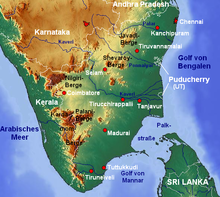Ponnaiyar River
This article has multiple issues. Please help improve it or discuss these issues on the talk page. (Learn how and when to remove these messages)
|
| South Pennar Thenpennai Ponnaiyar Dakshina Pinakini | |
|---|---|
 Krishnagiri Dam across the river | |
 Map of the South Pennar river flowing through Karnataka and Tamil Nadu | |
| Location | |
| Country | India |
| States | Karnataka and Tamil Nadu |
| Largest city | Bangalore |
| Cities | |
| Physical characteristics | |
| Source | Nandi Hills |
| • location | Chikkaballapura, Karnataka |
| • elevation | 1,276 m (4,186 ft) |
| Mouth | Bay of Bengal |
• location | Cuddalore, Tamil Nadu |
• coordinates | 11°46′19″N 79°47′40″E / 11.772°N 79.7945°E |
• elevation | 0 m (0 ft) |
| Length | 500 km (310 mi) |
| Basin features | |
| Tributaries | |
| • left | Pambar River |
| • right | Vanniyar River |
The South Pennar River (also known as Dakshina Painakini in Kannada and Thenpennai or Ponnaiyar or Pennaiyar in Tamil) is a river in India. It is the second longest river in Tamil Nadu, with a length of 497 km, after the Kaveri. Chandapura, Anekal, Hosur, Bagalur and Chengam are the major industrial settlements on its banks. The river is severely polluted by industrial waste as it flows through major industrial areas in the eastern suburbs of Bangalore and the industrial parks of Hosur and Chengam.[citation needed]
The river originates in the Nandi Hills in the Chikkaballapura district of Karnataka and flows through Tamil Nadu before emptying into the Bay of Bengal. It has a catchment area of 1,424 square miles (3,690 km2) located in Karnataka and Tamil Nadu states. The small Kelavarapalli and Krishnagiri Dams were built across this river near Hosur and Krishnagiri.[1] The largest dam on this river, Sathanur Dam with 7.3 Tmcft Gross Capacity is near Tiruvannamalai. The Moongilthuraipattu Sugar Factory is also situated on the bank of river.[citation needed]
The river is dry most of the year. Water flows during the monsoon season when it is fed by the south-west monsoon in the catchment area and the northeast monsoon in Tamil Nadu. This water flow raises the water table throughout the river basin and feeds numerous reservoirs/tanks.
The old river Dakshina Pinakini no longer exists.[2] A substantial part of Bangalore's sewage enters this river via Bellandur and Varthur Lakes and other channels.[3]
The sand buildup in the river is quite impressive, suggesting that it may have been a perennial river with much larger water flow in the past. Mentions of the river are found in Sangam and medieval (Tevaram - Bhakti cult era) literature, where it is depicted as rich with lush vegetation on its banks. There are Famous temples on its banks like Penneswaraar Temple,Shree Venkateshwara Swamy temple, Dakshina Tirupati, Veerateshwarar Temple and Kabilar Kundru . It is used to irrigate Chikkaballapur district, Bengaluru Rural district, Bengaluru Urban district, Kolar districtKrishnagiri district, Dharmapuri district, Tiruvannamalai, Viluppuram district, and Cuddalore district. It splits into a delta on which Cuddalore town is located.[citation needed]
The river is now looted for its rich abundance of sand. As the water flow will be only in monsoon seasons, the river is dry in remaining parts of the year.[citation needed]
See also
[edit]References
[edit]- ^ Kelavarapalli dam
- ^ P M Raghunandan (23 April 2012). "TN now lays claim to City sewage". Bangalore: Deccan Herald. Retrieved 19 August 2016.
- ^ S. Prasad (19 April 2005). "Water from Krishnagiri dam raises a scare". The Hindu. Archived from the original on 19 April 2005. Retrieved 19 August 2016.
This article needs additional citations for verification. (July 2012) |
This article needs to be updated. The reason given is: Flooding of Dakshina Pinakini in 2022. (September 2022) |
}}
